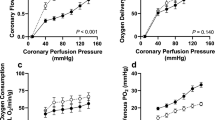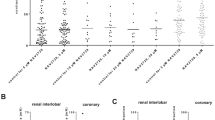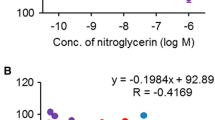Abstract
We investigated the relative contribution of basal and agonist stimulated EDRF/NO release to the adjustment of coronary tone and myocardial perfusion in conscious dogs by inhibiting coronary endothelial NO formation with NG-nitro-l-arginine methyl ester (l-NAME). Chronically instrumented conscious dogs (n = 9) were prepared for measurement of mean arterial blood pressure (MAP), heart rate (HR), coronary blood flow (CF) and diameter of the left circumflex (CDLC) and left anterior descending (CDLAD) coronary artery, respectively. Intracoronary infusions of l-NAME (30.3 mM; 0.25 ml × min−1) caused significant increases in MAP and decreases in HR. CDLC decreased by 3.8% from 3.01 ± 0.04 to 2.90±0.04 mm and CF decreases by 30% from 12.9 ± 0.2 to 9.1 ± 0.2 (aU). Peak reactive hyperemia (CFmax) evoked by 20-s-lasting occlusions of the left circumflex coronary artery decreased from 29.9 ± 0.8 to 25.8 ± 1.0 aU and maximal flow-dependent coronary dilation were reduced from 2.04 ± 0.08 to 0.91±0.12% after inhibition of NO-synthesis. Intracoronary infusions of acetylcholine (ACh), Adenosinc (Ado), bradykinin (Bk), and papaverine (Pap) caused dose-dependent increases in CDLC and CE Infusion of l-NAME nearly abolished the dilator effect of Ado on CDLC and reduced those to ACh, Bk and Pap. Increases in CF to ACh, Ado and Bk but not to Pap were reduced by l-NAME. Subsequent intracoronary infusions of l-arginine (303 mM; 0.25 ml × min−1) reduced l-NAME-induced CF-changes partly, but did not reverse coronary constriction. These results suggest that inhibition of the continuous release of nitric oxide markedly reduces myocardial perfusion in vivo. Endogenous dilator mechanisms are likewise impaired. Thus, in the heart, nitric oxide deficiency probably cannot be fully compensated for by counter-regulating mechanisms.
Similar content being viewed by others
References
Amrani M, O’Shea J, Allen NJ, Harding SE, Jayakumar J, Pepper JR, Moncada S, Yacoub MH (1992) Role of basal release of nitric oxide on coronary flow and mechanical performance of the isolated rat heart. J Physiol (Lond) 456:681–687
Bassenge E (1991) Endothelim-mediated regulation of coronary tone. Basic Res Cardiol 86:69–76
Bassenge E, Heusch G (1990) Endothelial and neuro-humoral control of coronary blood flow in health and disease. Rev Physiol Biochem Pharmacol 116:77–165
Bassenge E, Stewart DJ (1988) Interdependence of pharmacologically-induced and endothelium-mediated coronary vasodilation in antianginal therapy. Cardiovasc Drugs Ther 2:27–34
Bellan JA, Mcnamara DB, Kadowitz PJ (1993) Differential effects of nitric oxide synthesis inhibitors on vascular resistance and responses to acetylcholine in cats. Am J Physiol Heart Circ Physiol 264: H45-H52
Bogle RG, Moncada S, Pearson JD, Mann GE (1992) Identification of inhibitors of nitric oxide synthase that do not interact with the endothelial cell l-arginine transporter. Br J Pharmacol 105:768–770
Broten TP, Miyashiro S, Miyashiro JK, Moncada S, Feigl EO (1992) Role of endothelium-derived relaxing factor in parsympathetic coronary vasodilation. Am J Physiol 262:H1579-H1584
Busse R, Pohl U, Mülsch A, Bassenge E (1989) Modulation of the vasodilator action of SIN-1 by the endothelium. J Cardiovasc Pharmacol 14:S81-S85
Buxton IL, Check DJ, Eckman D, Westfall DP, Sanders KM, Keef KD (1993) NG-Nitro-l-arginine methyl ester and other alkyline esters of arginine are muscarinic receptor antagonists. Circ Res 72:387–395
Chu A, Chambers DE, Lin CC, Kuehl WD, Cobb FR (1990) Nitric oxide modulates epicardial coronary basal vasomotor tone in awake dogs. Am J Physiol 258:H1250-H1254
Chu A, Chambers DE, Lin CC, Kuehl WD, Palmer RMJ (1991) Effects of inhibition of nitric oxide formation on basal vasomotion and endothelium-dependent responses of the coronary arteries in awake dogs. J Clin Invest 87:1964–1968
Furchgott RF, Zawadzki JV (1980) The obligatory role of endothelial cells in the relaxation of arterial smooth muscle by acetylcholine. Nature 288:73–376
Horio T, Kohno M, Takeda T (1992) Effects of arginine vasopressin, angiotensin II and endothelin-1 on the release of brain natriuretic peptide in vivo and in vitro. Clin Exp Pharmacol Physiol 19:575–582
Ignarro LJ (1989) Biological actions and properties of endothelium-derived nitric oxide formed and released from artery and vein. Circ Res 65:1–21
Komas N, Lugnier C, Stoclet JC (1991) Endothelium-depenndent and independent relaxation of the rat aorta by cyclic nucleotide phosphodiesterase inhibitors. Br J Pharmacol 104:495–503
Lamontagne D, König A, Bassenge E, Busse R (1992) Prostacyclin and nitric oxide contribute to the vasodilator action of acetylcholine and bradykinin in the intact rabbit coronary bed. J Cardiovasc Pharmacol 20:652–657
Leipert B, Becker BF, Gerlach E (1992) Different endothelial mechanisms involved in coronary responses to known vasodilators. Am J Physiol Heart Circ Physiol 262:H1676-H1683
Lot TY, Stark G, Wilson VG (1993) Endothelium-dependent contractions to NG-nitro-l-arginine methyl ester in the porcine isolated splenic artery are sensitive to cyclooxygenase and lipoxygenase inhibitors. Naunyn Schmiedebergs Arch Pharmacol 347:115–118
Mcmahon TJ, Hood JS, Bellan JA, Kadowitz PJ (1991) Nomeganitro-l-arginine methyl ester selectively inhibits pulmonary vasodilator response to acetylcholine and bradykinin. J Appl Physiol 71:2026–2031
Moncada S, Palmer RMJ, Higgs EA (1988) The discovery of nitric oxide as the endogenous nitrovasodilator. Hypertension 12:365–372
Moncada S, Rees DD, Schulz R, Palmer RMJ (1991) Development and mechanism of a supersensitivity to nitrovasodilators after inhibition of vascular nitric oxide synthesis in vivo. Proc Natl Acad Sci 88: 2166–2170
Nagao T, Illiano S, Vanhoutte PM (1992) Heterogeneous distribution of endothelium-dependent relaxations resistant to NG-nitro-l-arginine in rats. Am J Physiol Heart Circ Physiol 263:H1090-H1094
Pacicca C, Von der Weid PY, Bény J-L (1992) Effect of nitro-l-arginine on endothelium-dependent hyperpolarizations and relaxations of pig coronary arteries. J Physiol (Lond) 457:247–256
Park KH, Rubin LE, Gross SS, Levi R (1992) Nitric oxide is a mediator of hypoxic coronary vasodilatation: Relation to adenosine and cyclooxygenase-derived metabolites. Circ Res 71:992–1001
Rafflenbeul W, Bassenge E, Lichtlen PR (1988) Nitroglycerin-induced dilation is enhanced in coronary artery segments with reduced endothelium-mediated dilation. Z Kardiol 77:75–82
Richard V, Berdeaux A, Drieu la Rochelle C, Giudicelly JF (1991) Regional coronary haemodynamic effects of two inhibitors of nitric oxide synthesis in anaesthetized, open-chest dogs. Br J Pharmacol 104:59–64
Rodman DM, Yamaguchi T, Hasunuma K, Obrien RF, McMurtry IF (1990) Effects of hypoxia on endothelium-dependent relaxation of rat pulmonary artery. Am J Physiol 258:L207-L214
Schwarzacher S, Raberger G (1992) l-NG-nitro-arginine methyl ester in the anesthetized rabbit: venous vasomotion and plasma levels. J Vase Res 29:290–292
Smith REA, Palmer RMJ, Bucknall CA, Moncada S (1992) Role of nitric oxide synthesis in the regulation of coronary vascular tone in the isolated perfused rabbit heart. Cardiovasc Res 26:508–512
Snyder SH, Bredt DS (1992) Biological roles of nitric oxide. Sci Am 266:28–35
Sonntag M, Deussen A, Schrader J (1992) Role of nitric oxide in local blood flow control in the anaesthetized dog. Pflugers Arch Eur J Physiol 420:194–199
Yamabe H, Okumura K, Ishizaka H, Tsuchiya T, Yasue H (1992) Role of endothelium-derived nitric oxide in myocardial reactive hyperemia. Am J Physiol Heart Cite Physiol 263:H8-H14
Author information
Authors and Affiliations
Additional information
Correspondence to: E. Bassenge at the above address
Rights and permissions
About this article
Cite this article
Huckstorf, C., Zanzinger, J., Fink, B. et al. Reduced nitric oxide formation causes coronary vasoconstriction and impaired dilator responses to endogenous agonists and hypoxia in dogs. Naunyn-Schmiedeberg’s Arch Pharmacol 349, 367–373 (1994). https://doi.org/10.1007/BF00170882
Received:
Accepted:
Published:
Issue Date:
DOI: https://doi.org/10.1007/BF00170882




